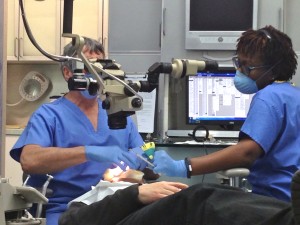I have written before about the wonders of Cone Beam Computed Tomography (CBCT) in helping endodontic diagnosis. Now I am going to highlight its role in helping us identify one of the more rare dental conditions – root resorption.
This is a process where the body’s cells dissolve the tooth structure. Like many of the human body’s processes, this can happen both positively and negatively. In children, for instance, resorption is the natural process which causes primary teeth – often known as milk teeth – to fall out.
In adults it can be problematic. One respected colleague calls resorption the Silent Terminator because there are no symptoms and when it’s not picked up it can be highly destructive. If left unchecked, the teeth become loose and will ultimately be lost.
Resorption has many causes. If you lose a tooth, the bone will gradually resorb and if a tooth is damaged, perhaps due to a fall or tripping up and banging your mouth, resorption may be triggered. What happens is that the periodontal ligaments, which hold the tooth in position, may become damaged. Over time, the roots become shorter and this puts the teeth are at risk.
Orthodontic treatment can be a potential risk factor for root resorption. It can be triggered when excessive force is applied to teeth too quickly. It’s a salutary reminder that while patients often want speedy treatment, it’s not necessarily in the long-term interests of the health of their teeth.
Orthodontic-related resorption isn’t usually the domain of an endodontist. We are more likely to see either internal or external resorption. It has been an infrequent but recurring condition among the patients presenting at the Harley Street Centre for Endodontics.
External root resorption occurs from outside the root. It’s more likely to occur in your front teeth, top and bottom, and the small telltale lesion is often concealed beneath the gumline. It can also be detected on an X-ray, as if a chunk of a root has gone missing. Internal resorption, which is rare, occurs inside the canal or pulp chamber. It’s like a hollow bubble which grows inside the tooth. If it’s severe, it can perforate the wall of the tooth.
Resorption can be the body’s response to inflammation as well as infection within the pulp of the tooth, where all the nerves are. When resorption starts, root canal therapy is needed to stop the process and prevent destruction of the remaining tooth structure.
If the resorptive defect is completely contained within the tooth and can be halted, there is a good chance of saving the tooth. If the lesion breaks through the wall of the tooth, there may be no hope.
If resorption is detected, referral to an endodontist needs to be made promptly. We can then decide if the tooth can be saved. The chief benefit of CBCT is that it gives us the fine detail we need for treatment planning.
The challenge for clinicians is in explaining to the patient what’s happened to their tooth and how the resorption has come about. In many cases we really don’t know. But we should build awareness of the condition, especially now that there is more chance of saving teeth with the assistance of CBCT.
Read More
